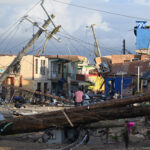Super typhoon Jelawat, or “sty 18w,” packing winds of 135 knots (155 mph – 250km/h) is currently located around 414 miles, 662 km, east-northeast of Manila, Philippines, according to the Pacific Joint Typhoon Warning Center (JTWC). It is moving slowly northwestward at around 5 mph, app. 7 km/h.
The JTWC’s bulletin, which is highly technical, said “recent animated water vapor satellite imagery shows that deep convection surrounding a 15 nm [17.26 mile, 27.6 km] eye has warmed slightly over the past six hours.” On the Saffir-Simpson scale used to measure the force of hurricanes, Jelawat would be a category 5 tropical cyclone, the most dangerous and destructive.
However, it is still far out in the Pacific Ocean; forecasts indicate that it will continue its northwestward movement as it moves towards the Equator. Once it reaches this “mid-latitude”, the JTWC expects it to show a “slower translational speed followed by a sharp turn to the east-northeast. Favorable upper-level conditions and passage over very warm water will enable sty 18w to remain a super typhoon or very strong typhoon for the next 24 hours.
“Thereafter, the peripheral upper-level flow around the building near-equatorial ridge will restrict outflow and vertical wind shear will increase slightly, inducing slow weakening through tau 72.” If Jelawat continues on that east-northeast track, it would not pose a serious threat to any land mass.
Source: Joint Typhoon Warning Center
Topics Catastrophe Natural Disasters
Was this article valuable?
Here are more articles you may enjoy.


 State Farm Sued Over Policies Backed by Distressed Insurer PHL
State Farm Sued Over Policies Backed by Distressed Insurer PHL  ‘Dream Is in Sight:’ Chamber, Reinsurers, Insurers Urge Florida to Stay the Course
‘Dream Is in Sight:’ Chamber, Reinsurers, Insurers Urge Florida to Stay the Course  Florida, East Coast to See Big Insured Losses From More Cat 5 Storms, Researchers Say
Florida, East Coast to See Big Insured Losses From More Cat 5 Storms, Researchers Say  Surveys Show Concerns About Florida Market, But Consumers Are Warming Up
Surveys Show Concerns About Florida Market, But Consumers Are Warming Up 

